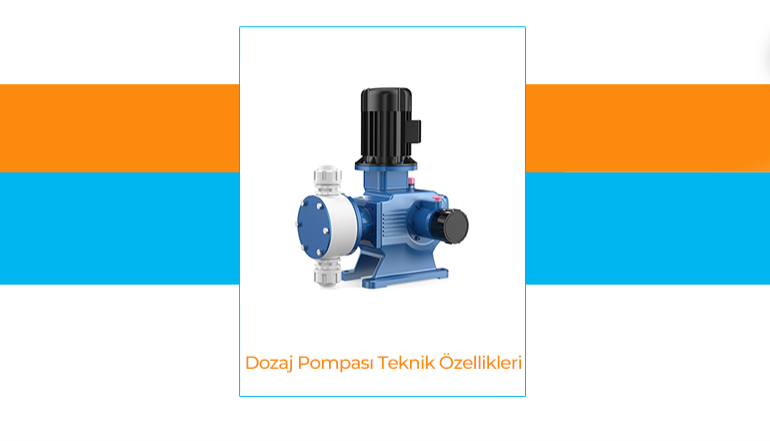- sisdoz@sisdoz.com.tr
- TR
Blog
- Home
- Sisdoz Blog
- Dosing Pump Technical Specifications

Dosing pumps are specialized equipment that provide precision, reliability, and control in industrial fluid transfer. They play a crucial role in the success of critical processes in the chemical, food, water treatment, pharmaceutical, and many other industries. However, understanding the technical specifications of the right dosing pump is the foundation for efficient and long-lasting use.
In this article, we examine the technical specifications of dosing pumps in detail and provide the information you will need for your selection process.
1. What is a Dosing Pump and Where Are They Used?
Dosing pumps are designed to dose fluids at a specific flow rate and pressure. They are particularly used in areas such as chemical addition, pH regulation, disinfection, and process control.
These pumps, which have a wide range of applications from industrial facilities to laboratory environments, can operate in continuous or intermittent modes.
2. Why Are Basic Technical Specifications Important?
The performance of a dosing pump is directly related to technical parameters such as flow rate, pressure, material quality, and control options.
A pump that lacks the correct specifications can reduce process efficiency, increase maintenance costs, and pose safety risks.
Therefore, technical details are critical not only for engineers but also for businesses seeking to increase operational efficiency.
3. Flow Range and Adjustability
Flow rate refers to the amount of fluid a dosing pump can transfer in a given period of time.
Adjustable flow control offers a significant advantage in adapting to different process requirements.
Modern dosing pumps can be precisely adjusted using manual adjustment knobs or digital control units.
Wide flow ranges are typically available, ranging from 0.1 L/h to 1000 L/h.
This feature is particularly critical in applications requiring precise quantities, such as chemical dosing.
4. Working Pressure Capacity
The maximum working pressure must be specified in the technical specifications of dosing pumps.
While 2-3 bar is sufficient for low-pressure applications, high-pressure industrial systems require 20 bar or more.
The pressure capacity should be selected based on the pipeline, tank system, and hydraulic structure of the process in which the pump will be used.
Incorrect pressure selection shortens pump life and compromises process safety.
5. Material Quality and Chemical Resistance
The material structure of dosing pumps must be compatible with the chemical properties of the fluid to be transported.
Materials such as PVC, PP, PVDF, PTFE, and stainless steel are the most preferred options.
Materials that offer high chemical resistance should be used in acidic or basic environments.
This feature ensures a long pump life and reduces maintenance requirements.
6. Power Source and Energy Consumption
Dosing pumps are generally powered by electric motors, pneumatic systems, or hydraulic power.
Electric dosing pumps are the most common type and are highly energy efficient.
Pneumatic pumps offer the advantage of safe operation in explosive environments.
Energy consumption values are important for operating costs, and efficient motor designs provide long-term savings.
7. Control Systems and Automation
In modern industrial applications, dosing pumps operate integrated with automation systems.
Fluid dosing can be adjusted automatically thanks to PLC, SCADA, or sensor-based control options.
Process monitoring is carried out with flow sensors, pH meters, and level detectors.
This minimizes human error and ensures just-in-time dosing.
8. Operating Modes and Flexibility
Dosing pumps can operate in constant flow, pulse-controlled, timed, or proportional dosing modes.
Proportional dosing automatically adjusts according to flow rate.
Time-controlled systems allow fluid addition at predetermined intervals.
This flexibility offers customized solutions in various sectors.
9. Ease of Maintenance and Spare Parts
Ease of maintenance is as important as technical specifications.
Pumps with simple assembly and disassembly features reduce maintenance times.
Easily available spare parts ensure operational continuity.
Brands with extensive manufacturer support and service networks should be preferred.
10. Tips for Choosing the Right Dosing Pump
The following steps should be followed when evaluating dosing pump specifications:
1. Analyze the chemical properties of the fluid.
2. Determine the required flow rate and pressure.
3. Select the appropriate material and power type.
4. Consider control and automation compatibility.
5. Check service and spare parts availability.
This way, you can achieve both performance and long-term cost advantages.
Conclusion: Technical Specifications Are the Key to Efficiency
The technical specifications of dosing pumps directly affect not only the operating principle of the device but also the efficiency, safety, and cost balance of your business.
Choosing a pump with the right technical specifications optimizes your processes, reduces maintenance costs, and improves production quality.
Frequently Asked Questions (FAQ)
1. What is a dosing pump?
A dosing pump is a type of industrial pump used to precisely dose fluids at a specific flow rate and pressure. It is used in many sectors, including chemical, food, pharmaceutical, and water treatment.
2. What are the most important technical specifications when selecting a dosing pump?
Flow range, maximum operating pressure, material quality, control systems, and ease of maintenance are the most important technical criteria in the selection process.
3. How is flow adjusted in dosing pumps?
Flow can be precisely adjusted using manual adjustment levers or digital control units. Some models integrate with automation systems to provide automatic flow control.
4. What materials are dosing pumps made of?
PVC, PP, PVDF, PTFE, and stainless steel are commonly used materials in the production of dosing pumps. Material selection is based on the chemical properties of the fluid to be transported.
5. What should be considered during dosing pump maintenance?
The pump should be cleaned regularly, wear parts such as seals and diaphragms should be replaced promptly, and the manufacturer's instructions should be followed.

